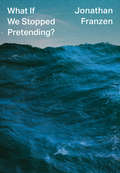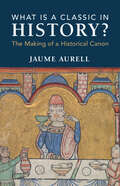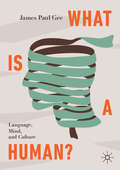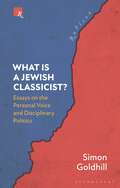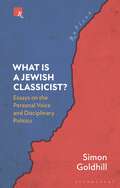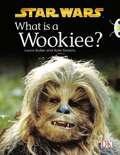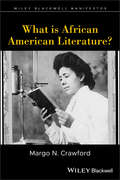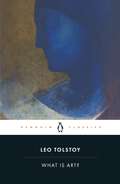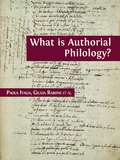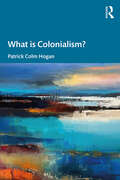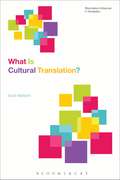- Table View
- List View
What if Derrida was wrong about Saussure?
by Russell DaylightThis book is an examination of Derrida's philosophical reconstruction of Saussurean linguistics, of the paradigm shift from structuralism to post-structuralism, and of the consequences that continue to resonate in every field of the humanities today.
What If We Stopped Pretending?
by Jonathan FranzenThe climate change is coming. To prepare for it, we need to admit that we can’t prevent it.
What Is a Classic?: Postcolonial Rewriting and Invention of the Canon (Cultural Memory in the Present)
by Ankhi MukherjeeWhat Is a Classic? revisits the famous question posed by critics from Sainte-Beuve and T. S. Eliot to J. M. Coetzee to ask how classics emanate from postcolonial histories and societies. Exploring definitive trends in twentieth- and twenty-first century English and Anglophone literature, Ankhi Mukherjee demonstrates the relevance of the question of the classic for the global politics of identifying and perpetuating so-called core texts. Emergent canons are scrutinized in the context of the wider cultural phenomena of book prizes, the translation and distribution of world literatures, and multimedia adaptations of world classics. Throughout, Mukherjee attunes traditional literary critical concerns to the value contestations mobilizing postcolonial and world literature. The breadth of debates and topics she addresses, as well as the book's ambitious historical schema, which includes South Asia, Africa, the Middle East, the West Indies, Australia, New Zealand, Europe, and North America, set this study apart from related titles on the bookshelf today.
What Is a Classic in History?: The Making of a Historical Canon
by null Jaume AurellWhat is a classic in historical writing? How do we explain the continued interest in certain historical texts, even when their accounts and interpretations of particular periods have been displaced or revised by newer generations of historians? How do these texts help to maintain the historiographical canon? Jaume Aurell's innovative study ranges from the heroic writings of ancient Greek historians such as Herodotus to the twentieth century microhistories of Carlo Ginzburg. The book explores how certain texts have been able to stand the test of time, gain their status as historiographical classics, and capture the imaginations of readers across generations. Investigating the processes of permanence and change in both historiography and history, Aurell further examines the creation of historical genres and canons. Taking influence from methodologies including sociology, literary criticism, theology, and postcolonial studies, What Is a Classic in History? encourages readers to re-evaluate their ideas of history and historiography alike.
What Is a Human?: Language, Mind, and Culture
by James Paul GeeIn a sweeping synthesis of new research in a number of different disciplines, this book argues that we humans are not who we think we are. As he explores the interconnections between cutting-edge work in bioanthropology, evolutionary biology, neuroscience, human language and learning, and beyond, James Paul Gee advances, also, a personal philosophy of language, learning, and culture, informed by his decades of work across linguistics and the social sciences. Gee argues that our schools, institutions, legal systems, and societies are designed for creatures that do not exist, thus resulting in multiple, interacting crises, such as climate change, failing institutions, and the rise of nationalist nationalism. As Gee constructs an understanding of the human that takes into account our social, collective, and historical nature, as established by recent research, he inspires readers to reflect for themselves on the very question of who we are—a key consideration for anyone interested in society, government, schools, health, activism, culture and diversity, or even just survival.
What Is a Jewish Classicist?: Essays on the Personal Voice and Disciplinary Politics (Rubicon)
by Simon GoldhillIn recent years, there has been no issue that has convulsed academia and its role in society more stridently than the personal politics of its institutions: who has access to education? How does who you are change what you study and how you engage with it? How does scholarship reflect the politics of society – how should it? These new essays from one of the best-known scholars of ancient Greece offer a refreshing and provocative contribution to these discussions. What is a Jewish Classicist? analyses how the personal voice of a scholar plays a role in scholarship, how religion and cultural identity are acted out within an academic discipline, and how translation, the heart of any engagement with the literature of antiquity, is a transformational practice. Topical, engaging, revelatory, this book opens a sharp and personal perspective on how and why the study of antiquity has become such a battlefield in contemporary culture. The first essay looks at how academics can and should talk about themselves, and how such positionality affects a scholar's work – can anyone can tell his or her own story with enough self-consciousness, sophistication and care? The second essay, which gives the book its title, takes a more socio-anthropological approach to the discipline, and asks how its patterns of inclusion and exclusion, its strategies of identification and recognition, have contributed to the shape of the discipline of classics. This initial enquiry opens into a fascinating history of change – how Jews were excluded from the discipline for many years but gradually after the Second World war became more easily assimilated into it. This in turn raises difficult questions for the current focus on race and colour as the defining aspects of personal identification, and about how academia reflects or contributes to the broader politics of society. The third essay takes a different historical approach and looks at the infrastructure or technology of the discipline through one of its integral and time-honoured practices, namely, translation. It discusses how translation, far from being a mere technique, is a transformational activity that helps make each classicist what they are. Indeed, each generation needs its own translations as each era redefines its relation to antiquity.
What Is a Jewish Classicist?: Essays on the Personal Voice and Disciplinary Politics (Rubicon)
by Simon GoldhillIn recent years, there has been no issue that has convulsed academia and its role in society more stridently than the personal politics of its institutions: who has access to education? How does who you are change what you study and how you engage with it? How does scholarship reflect the politics of society – how should it? These new essays from one of the best-known scholars of ancient Greece offer a refreshing and provocative contribution to these discussions. What is a Jewish Classicist? analyses how the personal voice of a scholar plays a role in scholarship, how religion and cultural identity are acted out within an academic discipline, and how translation, the heart of any engagement with the literature of antiquity, is a transformational practice. Topical, engaging, revelatory, this book opens a sharp and personal perspective on how and why the study of antiquity has become such a battlefield in contemporary culture. The first essay looks at how academics can and should talk about themselves, and how such positionality affects a scholar's work – can anyone can tell his or her own story with enough self-consciousness, sophistication and care? The second essay, which gives the book its title, takes a more socio-anthropological approach to the discipline, and asks how its patterns of inclusion and exclusion, its strategies of identification and recognition, have contributed to the shape of the discipline of classics. This initial enquiry opens into a fascinating history of change – how Jews were excluded from the discipline for many years but gradually after the Second World war became more easily assimilated into it. This in turn raises difficult questions for the current focus on race and colour as the defining aspects of personal identification, and about how academia reflects or contributes to the broader politics of society. The third essay takes a different historical approach and looks at the infrastructure or technology of the discipline through one of its integral and time-honoured practices, namely, translation. It discusses how translation, far from being a mere technique, is a transformational activity that helps make each classicist what they are. Indeed, each generation needs its own translations as each era redefines its relation to antiquity.
What is a Wookiee? (Purple B) NF (PDF)
by Laura BullerIn Star Wars, lots of creatures live far, far away in space. This book will tell you about some of them. You will learn about Wookiees and many other amazing creatures. Find out about furry, friendly Wookiees, and other aliens from the Star Wars world.
What is African American Literature? (Wiley-Blackwell Manifestos)
by Margo N. CrawfordAfter Kenneth W. Warren's What Was African American Literature?, Margo N. Crawford delivers What is African American Literature? The idea of African American literature may be much more than literature written by authors who identify as "Black". What is African American Literature? focuses on feeling as form in order to show that African American literature is an archive of feelings, a tradition of the tension between uncontainable black affect and rigid historical structure. Margo N. Crawford argues that textual production of affect (such as blush, vibration, shiver, twitch, and wink) reveals that African American literature keeps reimagining a black collective nervous system. Crawford foregrounds the "idea" of African American literature and uncovers the "black feeling world" co-created by writers and readers. Rejecting the notion that there are no formal lines separating African American literature and a broader American literary tradition, Crawford contends that the distinguishing feature of African American literature is a "moodscape" that is as stable as electricity. Presenting a fresh perspective on the affective atmosphere of African American literature, this compelling text frames central questions around the "idea" of African American literature, shows the limits of historicism in explaining the mood of African American literature and addresses textual production in the creation of the African American literary tradition. Part of the acclaimed Wiley Blackwell Manifestos series, What is African American Literature? is a significant addition to scholarship in the field. Professors and students of American literature, African American literature, and Black Studies will find this book an invaluable source of fresh perspectives and new insights on America's black literary tradition.
What is African American Literature? (Wiley-Blackwell Manifestos)
by Margo N. CrawfordAfter Kenneth W. Warren's What Was African American Literature?, Margo N. Crawford delivers What is African American Literature? The idea of African American literature may be much more than literature written by authors who identify as "Black". What is African American Literature? focuses on feeling as form in order to show that African American literature is an archive of feelings, a tradition of the tension between uncontainable black affect and rigid historical structure. Margo N. Crawford argues that textual production of affect (such as blush, vibration, shiver, twitch, and wink) reveals that African American literature keeps reimagining a black collective nervous system. Crawford foregrounds the "idea" of African American literature and uncovers the "black feeling world" co-created by writers and readers. Rejecting the notion that there are no formal lines separating African American literature and a broader American literary tradition, Crawford contends that the distinguishing feature of African American literature is a "moodscape" that is as stable as electricity. Presenting a fresh perspective on the affective atmosphere of African American literature, this compelling text frames central questions around the "idea" of African American literature, shows the limits of historicism in explaining the mood of African American literature and addresses textual production in the creation of the African American literary tradition. Part of the acclaimed Wiley Blackwell Manifestos series, What is African American Literature? is a significant addition to scholarship in the field. Professors and students of American literature, African American literature, and Black Studies will find this book an invaluable source of fresh perspectives and new insights on America's black literary tradition.
What is Art?: What Is Art? The Christian Teaching - Scholar's Choice Edition (Barnes And Noble Digital Library)
by Leo Tolstoy Larissa Volokhonsky Richard PevearDuring his decades of world fame as a novelist, Tolstoy also wrote prolifically in a series of essays and polemics on issues of morality, social justice and religion. These works culminated in What is Art?, published in 1898. Impassioned and iconoclastic, this powerfully influential work both criticizes the elitist nature of art in nineteenth-century Western society, and rejects the idea that its sole purpose should be the creation of beauty. The works of Dante, Michelangelo, Shakespeare, Beethoven, Baudelaire and Wagner are all vigorously condemned, as Tolstoy explores what he believes to be the spiritual role of the artist - arguing that true art must work with religion and science as a force for the advancement of mankind.
What is Authorial Philology?
by Paola Italia;Giulia Raboni et al.A stark departure from traditional philology, What is Authorial Philology? is the first comprehensive treatment of authorial philology as a discipline in its own right. It provides readers with an excellent introduction to the theory and practice of editing ‘authorial texts’ alongside an exploration of authorial philology in its cultural and conceptual architecture. The originality and distinction of this work lies in its clear systematization of a discipline whose autonomous status has only recently been recognised (at least in Italy), though its roots may extend back as far as Giorgio Pasquali. This pioneering volume offers both a methodical set of instructions on how to read critical editions, and a wide range of practical examples, expanding upon the conceptual and methodological apparatus laid out in the first two chapters. By presenting a thorough account of the historical and theoretical framework through which authorial philology developed, Paola Italia and Giulia Raboni successfully reconceptualize the authorial text as an ever-changing organism, subject to alteration and modification. What is Authorial Philology? will be of great didactic value to students and researchers alike, providing readers with a fuller understanding of the rationale behind different editing practices, and addressing both traditional and newer methods such as the use of the digital medium and its implications. Spanning the whole Italian tradition from Petrarch to Carlo Emilio Gadda, this ground-breaking volume provokes us to consider important questions concerning a text’s dynamism, the extent to which an author is ‘agentive’, and, most crucially, about the very nature of what we read.
What Is China?: Territory, Ethnicity, Culture, and History
by Ge ZhaoguangGe Zhaoguang, an eminent historian of traditional China and a public intellectual, takes on fundamental questions that shape the domestic and international politics of the world’s most populous country and its second largest economy. What Is China? offers an insider’s account that addresses sensitive problems of Chinese identity and shows how modern scholarship about China—whether conducted in China, East Asia, or the West—has attempted to make sense of the country’s shifting territorial boundaries and its diversity of ethnic groups and cultures. Ge considers, for example, the ancient concept of tianxia, or All-Under-Heaven, which assigned supremacy to the imperial court and lesser status to officials, citizens, tributary states, and tribal peoples. Does China’s government still operate with a belief in divine rule of All-Under-Heaven, or has it taken a different view of other actors, inside and outside its current borders? Responding both to Western theories of the nation-state and to Chinese intellectuals eager to promote “national learning,” Ge offers an insightful and erudite account of how China sees its place in the world. As he wrestles with complex historical and cultural forces guiding the inner workings of an often misunderstood nation, Ge also teases out many nuances of China’s encounter with the contemporary world, using China’s past to explain aspects of its present and to provide insight into various paths the nation might follow as the twenty-first century unfolds.
What Is China?: Territory, Ethnicity, Culture, and History
by Ge ZhaoguangGe Zhaoguang, an eminent historian of traditional China and a public intellectual, takes on fundamental questions that shape the domestic and international politics of the world’s most populous country and its second largest economy. What Is China? offers an insider’s account that addresses sensitive problems of Chinese identity and shows how modern scholarship about China—whether conducted in China, East Asia, or the West—has attempted to make sense of the country’s shifting territorial boundaries and its diversity of ethnic groups and cultures. Ge considers, for example, the ancient concept of tianxia, or All-Under-Heaven, which assigned supremacy to the imperial court and lesser status to officials, citizens, tributary states, and tribal peoples. Does China’s government still operate with a belief in divine rule of All-Under-Heaven, or has it taken a different view of other actors, inside and outside its current borders? Responding both to Western theories of the nation-state and to Chinese intellectuals eager to promote “national learning,” Ge offers an insightful and erudite account of how China sees its place in the world. As he wrestles with complex historical and cultural forces guiding the inner workings of an often misunderstood nation, Ge also teases out many nuances of China’s encounter with the contemporary world, using China’s past to explain aspects of its present and to provide insight into various paths the nation might follow as the twenty-first century unfolds.
What is Colonialism?
by Patrick Colm HoganWhat is Colonialism? develops a clear and rigorous account of what colonialism is and how it works. It draws on and synthesizes recent work in cognitive science, affective science, and social psychology, along with Marxism and related forms of analysis. Hogan begins with some fundamental conceptual distinctions, such as the degree to which a group shares beliefs, dispositions, and skills versus the degree to which they share identification with a category. Building on these distinctions, he defines colonialism in terms of political, economic, and cultural autonomy, clarifying the nature of culture and autonomy particularly. He goes on to articulate an invaluable systematic account of the varieties of colonialism. The final chapters outline the motives of imperialists, differentiating these from their ideological rationalizations, and sketching the harms caused by colonialism. The book concludes by considering when, or if, one can achieve a genuinely postcolonial condition. Hogan illustrates these analyses by examining influential literary works—by European writers (such as Joseph Conrad) and by non-Europeans (such as Athol Fugard, Kamala Markandaya, and Wole Soyinka). This accessible and informative volume is the ideal resource for students and scholars interested in colonialism and empire.
What is Colonialism?
by Patrick Colm HoganWhat is Colonialism? develops a clear and rigorous account of what colonialism is and how it works. It draws on and synthesizes recent work in cognitive science, affective science, and social psychology, along with Marxism and related forms of analysis. Hogan begins with some fundamental conceptual distinctions, such as the degree to which a group shares beliefs, dispositions, and skills versus the degree to which they share identification with a category. Building on these distinctions, he defines colonialism in terms of political, economic, and cultural autonomy, clarifying the nature of culture and autonomy particularly. He goes on to articulate an invaluable systematic account of the varieties of colonialism. The final chapters outline the motives of imperialists, differentiating these from their ideological rationalizations, and sketching the harms caused by colonialism. The book concludes by considering when, or if, one can achieve a genuinely postcolonial condition. Hogan illustrates these analyses by examining influential literary works—by European writers (such as Joseph Conrad) and by non-Europeans (such as Athol Fugard, Kamala Markandaya, and Wole Soyinka). This accessible and informative volume is the ideal resource for students and scholars interested in colonialism and empire.
What Is Cultural Translation? (Bloomsbury Advances in Translation)
by Sarah MaitlandWhat Is Cultural Translation? In this book, Sarah Maitland uncovers processes of negotiation and adaptation closely associated with the translation of languages behind the cultural phenomena of everyday life. For globalized societies confronted increasingly with the presence of difference in all its forms, translation has become both a metaphor for thoughtful encounter and a touchstone act for what we see, do and say, and who we are.Drawing on examples from across cultural domains (theatre, film, TV and literature) this work illuminates the elusive concept of 'cultural translation'. Focusing on the built environment, current affairs, international relations and online media, this book arrives at a view of translation in its broadest sense. It is a means for decoding how we shape the cultural realm and serves as a vehicle for new ways of seeing and being that question the received ideas that structure the communities in which we live.Written in a clear and engaging style, this is the first book-length study of cultural translation. It builds a powerful case for expanding the remit of translation to cover the experience of living and working in a globalized, multicultural world, and is of interest to all involved in the academic study of representation and contestation in contemporary cultural practice.
What Is Cultural Translation? (Bloomsbury Advances in Translation)
by Sarah MaitlandWhat Is Cultural Translation? In this book, Sarah Maitland uncovers processes of negotiation and adaptation closely associated with the translation of languages behind the cultural phenomena of everyday life. For globalized societies confronted increasingly with the presence of difference in all its forms, translation has become both a metaphor for thoughtful encounter and a touchstone act for what we see, do and say, and who we are.Drawing on examples from across cultural domains (theatre, film, TV and literature) this work illuminates the elusive concept of 'cultural translation'. Focusing on the built environment, current affairs, international relations and online media, this book arrives at a view of translation in its broadest sense. It is a means for decoding how we shape the cultural realm and serves as a vehicle for new ways of seeing and being that question the received ideas that structure the communities in which we live.Written in a clear and engaging style, this is the first book-length study of cultural translation. It builds a powerful case for expanding the remit of translation to cover the experience of living and working in a globalized, multicultural world, and is of interest to all involved in the academic study of representation and contestation in contemporary cultural practice.
What Is English?: And Why Should We Care?
by Tim William MachanWhat is English? Can we be as certain as we usually are when we say something is not English? To find some answers Tim Machan explores the language's present and past, and looks ahead to its futures among the one and a half billion people who speak it. His search is fascinating and important, for definitions of English have influenced education and law in many countries and helped shape the identities of those who live in them. Finding an account that fits the constantly changing varieties of English is, Tim Machan finds, anything but simple. But he rises to the challenge, grappling with its elusive essence through episodes in its history. He looks at the ambitions of Caxton, the preoccupations of Johnson, and the eloquence of Churchill, tussles with the jargons of contemporary business, and pursues his object from rural America to James Cook's Australia. He examines creoles, pidgins, and dialects, and takes apart competing histories showing their assumptions and prejudices. Finally he reveals the stable category English, resting paradoxically within its constantly mutating forms and varieties. This is a book for everyone interested in English and the role of language in society and culture.
What is Film Theory? (UK Higher Education OUP Humanities & Social Sciences Media, Film & Cultural Studies)
by Richard Rushton Gary Bettinson"...[A]uthoritative, always engaged, and grounded in the detailed study of well chosen films. This is an exceptionally useful introduction, and good to read."Professor James Donald, The University of New South Wales, AustraliaThis engaging and accessible book explores major debates in contemporary film theory, providing a detailed introduction to the central arguments advanced by film theorists since the 1960s.What is Film Theory? outlines the discipline's key theoretical concepts, perspectives, and traditions, and critically examines the assertions posited by exemplary film theorists and philosophers of film. A step-by-step approach to these issues guides the reader through the central topics of film theory. Beginning with a discussion of structuralism and semiotics, and moving through debates on psychoanalysis, feminism, Screen theory, and cultural studies, the authors then examine the perspectives of 'post-theory', cognitivism, and historical poetics, as well as recent developments such as audience research and the 'cinema of attractions'.Analysis of the major theories is supported with detailed and wide-ranging case studies of particular films, including Singin' in the Rain, The Searchers, Tout va bien, Jaws, Do the Right Thing, Brokeback Mountain, and Sweeney Todd: The Demon Barber of Fleet Street. These case studies are accompanied by a series of illustrative film and production stills.What is Film Theory? is indispensable reading for all students of Film and Media Studies, as well as for general readers interested in the debates which have defined film theory.
What Is Global History?
by Sebastian ConradUntil very recently, historians have looked at the past with the tools of the nineteenth century. But globalization has fundamentally altered our ways of knowing, and it is no longer possible to study nations in isolation or to understand world history as emanating from the West. This book reveals why the discipline of global history has emerged as the most dynamic and innovative field in history—one that takes the connectedness of the world as its point of departure, and that poses a fundamental challenge to the premises and methods of history as we know it.What Is Global History? provides a comprehensive overview of this exciting new approach to history. The book addresses some of the biggest questions the discipline will face in the twenty-first century: How does global history differ from other interpretations of world history? How do we write a global history that is not Eurocentric yet does not fall into the trap of creating new centrisms? How can historians compare different societies and establish compatibility across space? What are the politics of global history? This in-depth and accessible book also explores the limits of the new paradigm and even its dangers, the question of whom global history should be written for, and much more.Written by a leading expert in the field, What Is Global History? shows how, by understanding the world's past as an integrated whole, historians can remap the terrain of their discipline for our globalized present.
What Is Global History?
by Sebastian ConradUntil very recently, historians have looked at the past with the tools of the nineteenth century. But globalization has fundamentally altered our ways of knowing, and it is no longer possible to study nations in isolation or to understand world history as emanating from the West. This book reveals why the discipline of global history has emerged as the most dynamic and innovative field in history—one that takes the connectedness of the world as its point of departure, and that poses a fundamental challenge to the premises and methods of history as we know it.What Is Global History? provides a comprehensive overview of this exciting new approach to history. The book addresses some of the biggest questions the discipline will face in the twenty-first century: How does global history differ from other interpretations of world history? How do we write a global history that is not Eurocentric yet does not fall into the trap of creating new centrisms? How can historians compare different societies and establish compatibility across space? What are the politics of global history? This in-depth and accessible book also explores the limits of the new paradigm and even its dangers, the question of whom global history should be written for, and much more.Written by a leading expert in the field, What Is Global History? shows how, by understanding the world's past as an integrated whole, historians can remap the terrain of their discipline for our globalized present.
What is Good Academic Writing?: Insights into Discipline-Specific Student Writing (New Perspectives for English for Academic Purposes)
by Melinda Whong and Jeanne GodfreyThe field of English for Academic Purposes (EAP) developed to address the needs of students whose mother tongue is not English. However, the linguistic competence required to achieve academic success at any university where English is the medium of instruction is a challenge for all students. While there are linguistic features common to academic literacy as a general genre, closer investigation reveals significant differences from one academic field to another. This volume asks what good writing is within specific disciplines, focussing on student work. Each chapter provides key insights by EAP professionals, based on their research in which they bring together analysis of student writing and interviews with subject specialists and markers who determine what 'good writing' is in their discipline. The volume includes chapters on established disciplines which have had less attention in the EAP and academic writing literature to date, including music, formal linguistics, and dentistry, as well as new and growing fields of study such as new media.
What is Good Academic Writing?: Insights into Discipline-Specific Student Writing (New Perspectives for English for Academic Purposes)
The field of English for Academic Purposes (EAP) developed to address the needs of students whose mother tongue is not English. However, the linguistic competence required to achieve academic success at any university where English is the medium of instruction is a challenge for all students. While there are linguistic features common to academic literacy as a general genre, closer investigation reveals significant differences from one academic field to another. This volume asks what good writing is within specific disciplines, focussing on student work. Each chapter provides key insights by EAP professionals, based on their research in which they bring together analysis of student writing and interviews with subject specialists and markers who determine what 'good writing' is in their discipline. The volume includes chapters on established disciplines which have had less attention in the EAP and academic writing literature to date, including music, formal linguistics, and dentistry, as well as new and growing fields of study such as new media.
What Is Good Writing?
by Geoffrey HuckThough we all think we know what good writing is when we see it, it's difficult to define it precisely; and without a satisfactory definition, it becomes problematical to assess as well as to teach. In What Is Good Writing?, Geoffrey J. Huck advances the contemporary debate on writing achievement by drawing on empirical research in linguistics and the other cognitive sciences that shed light on the development of fluency in language. The utility of defining "good writing" as "fluent writing" or writing that is on par with the typical fluency in speech attained by normal adults, is demonstrated by the progress it permits in evaluating the success of current writing programs in school and university--programs which, for the most part, have proved unable to deliver writing assessments that are both valid and reliable. Huck advances an alternative approach that rests on more scientific footing. He explains why reading is key to good writing and why standard composition programs often do not live up to their aspirations.

